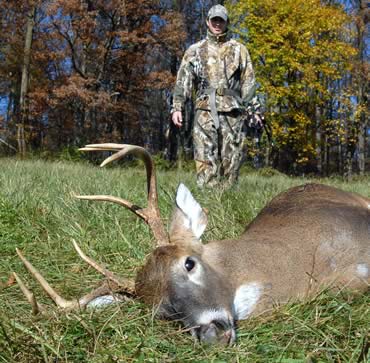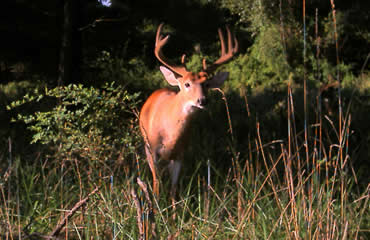By P.J. Reilly
Looking for the perfect something to hang next to that Elvis painting?
Sitting in my stand for Maryland’s archery deer season opener, I could feel sweat beads rolling down my chest and back. It was hot, and the evening sit was going to be brutal.
But it was opening day!
My stand hung in a tulip poplar about 50 yards off a soybean field. A well-worn trail stretched from the field to a bedding thicket 200 yards downhill from my tree. Scouting in July and August let me know six bucks ran this trail out to the field nearly every evening. One of them was a solid 10-pointer that I was itching to tag.
Every time I watched that trail, the big boy was the last buck out to the field. The others, which were much smaller, would scamper single-file into the beans without a care in the world. About five minutes later, the boss would appear at the spot where the trail met the field edge, and he’d survey the open country carefully before stepping out of the woods.
My plan for opening day was to be in my stand four hours before sunset and wait for the parade. The five young bucks would all get passes. My bow would only be pressed into service if the 10-pointer showed.
I sweated profusely until just before sunset, when deer started filtering out toward the field. The five young bucks soon appeared on the trail beneath me. One by one, they filed past. Two 7-pointers still wore velvet coverings on their antlers. I’d never shot a buck in velvet before — and I still haven’t — so I’d be lying if I didn’t admit I thought of taking a crack at the larger of the two bucks.
“No way,” the voice inside my head quickly called out. “Wait for Mr. Big.”
I never picked up my bow, and the young bucks all walked out to the field for dinner. Several minutes passed, and the 10-pointer was nowhere to be seen. On my scouting missions, he’d never been this far behind his buddies. I started to worry.
About the thousandth time I looked down toward the bedding area, there he was. When I first saw him, the big buck was stepping gingerly through a tangle of grapevines. Once clear of the thicket, he jumped onto the trail and walked toward me with his head up, looking from side to side.
I guessed the buck’s rack would score somewhere in the 150s, and I was already mentally putting those antlers on my wall as I stood and picked up my bow. When the buck approached to within 70 yards, my heart rate increased dramatically. I could feel the veins in my temples pounding away.
And then I heard a gunshot. Followed by another and another. The neighbor started squeezing off rounds on his target range. I felt all the blood rush out of my face as I turned toward the buck and saw him standing stone still with his head up and his ears locked forward. He stood like that for what seemed like an eternity before he flicked his tail once, turned and trotted back toward the thicket with his head low to the ground.
 I never saw that buck again.
I never saw that buck again.
Sorry that story ended on such a sour note, but despite the way it turned out, I had done everything right. I had found the buck, figured out where to position myself to get a shot, and the deer was coming right on schedule. The neighbor was an X-factor beyond my control.
The experience furthered my conviction that North America’s early deer seasons, which open on or before mid-September, offer hunters some of the best opportunities to pattern and kill trophy-class bucks. They also offer the only opportunities at taking bucks in velvet. By the time October rolls around, white-tailed bucks are all but guaranteed to be in hard antler.
Twenty-one states and two Canadian provinces offer seasons that start on or before Sept. 15. Six states — Washington, Idaho, Oregon, Delaware, South Carolina and Wyoming — and Manitoba schedule season openers on or before Sept. 1. Except for South Carolina, Kansas and South Dakota, states and provinces catering to the early birds reserve the woods and fields for bowbenders.
South Carolina allows gun hunting beginning Aug. 15 in certain zones. Kansas opens its first gun hunting season on Sept. 11, but it’s limited to kids and disabled hunters. Gun hunting is allowed during South Dakota’s early season, which typically opens about Sept. 12, but that season is restricted to youth hunters as well.
As a member of the Primos video team, Keith Burgess hunts all over North America, from the first day of the earliest season to the last day of the latest season. Asked to choose his favorite season to hunt for big bucks, Burgess doesn’t have to think.
“Early September, no doubt, is my favorite time of year to hunt the big bucks,” he said. “It’s the only time I know of where you can find a big buck, pattern him and then hunt him according to that pattern.”
Every year, the Primos video team is in Wyoming or Montana in early September, hunting and filming. Burgess knows a lot of hunters focus their attention on the rut, when swollen-necked bruisers are out roaming far and wide in search of love. But that’s exactly the problem with hunting the rut, he said.
“You don’t really hunt a big buck during the rut,” Burgess said. “You hunt the does and hope the big boy shows up. But he might not.”
In late August and early September, Burgess likes to find a vantage point overlooking a crop field or food plot. When deer start filtering out, he’ll search for a trophy buck and pay attention to where that deer enters the field.
“In the real early season, you can feel pretty confident that a deer is going to do the same thing nearly every day,” he said. “They haven’t really been pressured yet. They aren’t fighting with other bucks, and they basically just go from bedding areas to feeding areas and back again.”
For the past 16 years, Jeff Smith has been guiding bowhunters as the owner of Seven J Outfitters in Sundance, Wyo. Every year, Smith has hunters on stand Sept. 1.
“The thing I like about that time of year is the deer aren’t messed with at all,” he said. “And they’re still in their late-summer patterns, when the bucks travel in groups. If you can locate and pattern a mature deer, those first few days in September are about as good a chance as you’ll have at getting that buck.”
Like Burgess, Smith scouts from long distance to keep from spooking the deer. Once he’s picked out a likely stand site, he’ll go in for a closer look only in the middle of the day.
 “You’re less likely to spook a deer if you’re in the woods between 10 a.m. and 2 p.m.,” he said.
“You’re less likely to spook a deer if you’re in the woods between 10 a.m. and 2 p.m.,” he said.
Both Smith and Burgess said they prefer hunting from treestands to help with scent control. Every bowhunter knows, or soon learns, it’s important to control scent. Hunt from 20 feet up a tree, and it’s possible your scent will blow up and over a deer’s nose.
Even then, it’s critical to mask and kill human odors in the early seasons.
Everything I wear and carry on an early season hunt gets sprayed with some form of scent-control product. And I carry scent-killing field wipes for my face, head and hands.
Humans have as many as five million secretory glands in our skin. Eccrine glands are found throughout the body, with the greatest concentrations in the feet and hands. Eccrine glands are capable of secreting as much as four liters of sweat in one hour. While most of that sweat is water, it also contains odor-producing organic and inorganic substances — including ammonia and several acids — that we deposit on everything we touch.
Most bowhunters know to wear rubber boots in the early season, but gloves are equally important. Every twig you push out of the way and every rung on the ladder leading up to your stand that you touch with a gloveless, sweaty hand is a warning bell capable of sending a trophy buck the other way.
Both men said they almost exclusively hunt on or near fields during the early season.
“We have a lot of acorns in the area where we hunt, but it seems like in late August and early September, even the most mature deer quit feeding everywhere else to come to our hay fields,” Smith said. “They’ll walk right past a bunch of acorns to get to the green grass.”
Likewise, both men said they prefer hunting in the evening.
“It seems like, in that real early season, big bucks don’t bed too far off the fields,” Burgess said. “If you try getting in on them in the morning, you’re just going to spook them off the field and wreck your afternoon hunt.”
An exception, Smith said, is river-bottoms. “If you can find a good trail through a river bottom, hang a stand for a morning hunt,” he said. “The deer seem to head to water on their way back to the bedding area.”
Deer can go for several days without eating, but they have to drink water every day. Burgess said if he can’t hunt close to a field, he’ll try to find a water source. And when it’s really hot, he’d just as soon sit over a water hole than near a field.
A buck in velvet is a rare trophy, and that’s why many hunters brave the heat and mosquitoes each year and head to South Carolina’s low country in the eastern part of the Palmetto State for the Aug. 15 opener — the earliest opening day in North America.
Wyoming is the only other state with an Aug. 15 opener, and, like South Carolina, that’s only in certain areas. Pretty much all the bucks you’ll encounter that time of year are going to be in velvet.
Sifting through his extensive harvest records, Smith said his hunters have about a 50-50 chance at tagging a velvet buck from Sept. 1-8.
“After Sept. 8, it seems like most of the bucks pretty much have the velvet rubbed off,” he said. “That varies a couple of days from year to year, but, for the most part, Sept. 8 is about it.”
“That’s another reason I love hunting the early season,” Burgess said of having a chance at taking a velvet buck.
“And it seems like everybody around here has the same idea. When we start putting together our hunting schedule for the year, everybody’s always fighting over those early hunts around Sept. 1.”
When you plan your hunts this year, don’t just try to find free time during the rut. Head to one of the states or provinces that offer North America’s early bird hunts. You just might find the buck of your dreams, and he might be wrapped in velvet.
Read Recent Articles:
• Bow Bucks in the Deep Freeze: Cold-weather bowhunting requires extra practice.
• Right Time, Right Buck: Weather and an empty stomach get the best of this old warrior.
• Old White Foot: Four-year hunt ends in a cloud of smoke ... and a flood of emotions.
This article was published in the July 2010 edition of Buckmasters Whitetail Magazine. Subscribe today to have Buckmasters delivered to your home.